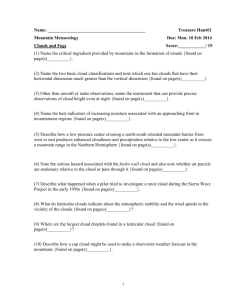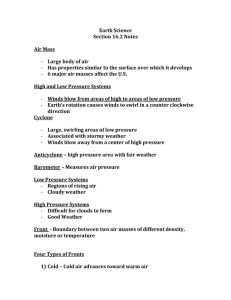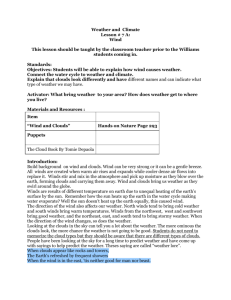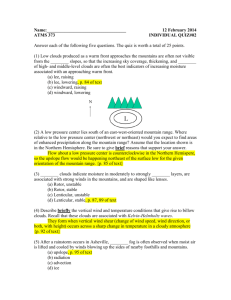Lesson Seven: Navigation II and Meteorology I
advertisement
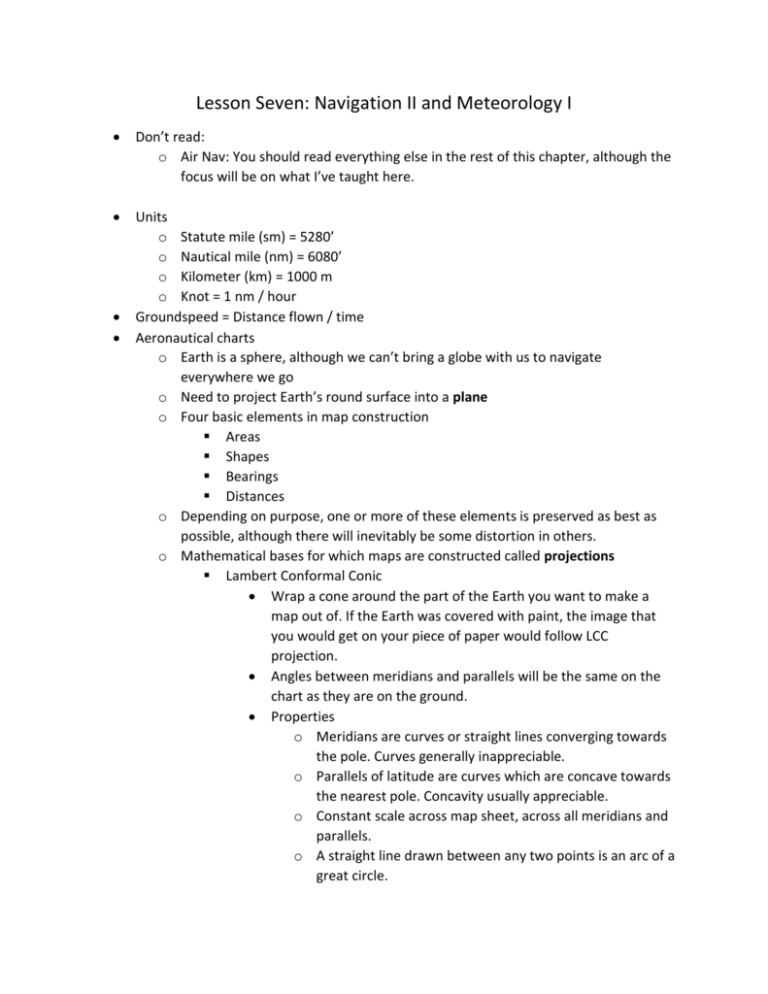
Lesson Seven: Navigation II and Meteorology I Don’t read: o Air Nav: You should read everything else in the rest of this chapter, although the focus will be on what I’ve taught here. Units o Statute mile (sm) = 5280’ o Nautical mile (nm) = 6080’ o Kilometer (km) = 1000 m o Knot = 1 nm / hour Groundspeed = Distance flown / time Aeronautical charts o Earth is a sphere, although we can’t bring a globe with us to navigate everywhere we go o Need to project Earth’s round surface into a plane o Four basic elements in map construction Areas Shapes Bearings Distances o Depending on purpose, one or more of these elements is preserved as best as possible, although there will inevitably be some distortion in others. o Mathematical bases for which maps are constructed called projections Lambert Conformal Conic Wrap a cone around the part of the Earth you want to make a map out of. If the Earth was covered with paint, the image that you would get on your piece of paper would follow LCC projection. Angles between meridians and parallels will be the same on the chart as they are on the ground. Properties o Meridians are curves or straight lines converging towards the pole. Curves generally inappreciable. o Parallels of latitude are curves which are concave towards the nearest pole. Concavity usually appreciable. o Constant scale across map sheet, across all meridians and parallels. o A straight line drawn between any two points is an arc of a great circle. The VFR Navigation Charts (VNC) and the World Aeronautical Charts (WAC) are based on the LCC projection. Mercator Wrap a cylinder around the Earth so that the cylinder would fit snugly in contact with the Earth’s equator (tangent at the equator) Properties o Meridians are straight and parallel lines. o Parallels are straight and parallel lines. o A straight line between any two points is a rhumb line. o No constant scale of distant; heavy distortion at high latitudes. Transverse Mercator o Variant of the Mercator, where the cylinder is rotated 90o such that the points of tangency are along a meridian (with a pole on either side) o Chart is then accurate along the selected meridian. o Accurate in depicting scale, esp. in small geographic areas. o Used on the VFR Terminal Area Charts (VTA) o Types of aeronautical charts VNC LCC projection Used for visual navigation at lower altitudes and slower speeds. Covers a fair swath of land, with moderate detail resolution. Northern half of coverage on one side, southern half on the other. Each chart identified by the name of principal landmark on the chart (typically a major city) Scale – 1:500,000 WAC LCC projection Designed for visual nav at higher altitudes and faster speeds. Covers a large land area, with low resolution. 18 charts cover the whole country. Scale—1:1,000,000 VTA Transverse Mercator Published for airports where there is large airplane traffic, and which there is a mix of controlled airspace Scale: 1:250,000 Read section on Canada Flight Supplement Further definitions o Required track: Proposed path of airplane over ground. o Track made good: Actual path of airplane over ground. o Track error: Angle between required track and track made good, measured in degrees left or right of required track. o Opening angle: Angle between the required track and the track made good. o Closing angle: Angle between the old required track and the new required track necessary to arrive at the destination. o One-in-sixty rule: An error in track of one degree will cause an error in position of about one mile in a distance of 60 miles. (Angle off track)/60 = (Miles off track) / (Miles travelled) Could also use trig ratios to solve, not sure if you’ll have access to a calculator during the exam (you should though) The Atmosphere o 78% nitrogen, 21% oxygen, 1% everything else o Of that “everything else”, the most important is water vapour in terms of weather; can only be found in lower levels of the atmosphere o Atmosphere has weight, which gives rise to pressure: P = F/A o Properties: mobility, capacity for expansion, capacity for compression Air can rise (and cool), air can descend (and warm), air can move horizontally (advection) o Troposphere Lowest layer of the atmosphere, where all of the weather happens Surface – 28000’ (at the poles) to 54000’ (at the equator) Within this layer, pressure, density and temperature decrease with altitude. Top layer of troposphere called tropopause o Stratosphere Layer roughly 50000’ from the tropopause Temperature increases with altitude to roughly 0oC at the stratopause Little water vapour here; some thunderstorm tops may punch through o Mesosphere o Thermosphere o Exosphere **International Civil Aviation Organization (ICAO) Standard Atmosphere (ISA) o Air is a perfectly dry gas o MSL pressure of 29.92’’ Hg (1013.25 hPa) o MSL temperature of 15oC o Rate of temperature decrease (lapse rate) is 1.98oC/1000’ Clouds o Condensation of the air, resulting in visible water droplets forming aloft o Occurs when a parcel of air becomes saturated (i.e. temperature = dew point) o Identified based on altitude of formation as well as how they form High (16500’ – 45000’), Middle (6500’ – 23000’), and Low (SFC – 6500’) Cumulus (cumuliform clouds) Form in rising air currents, evidence of unstable conditions Stratus (stratiform clouds) Form in horizontal layers, evidence of stable conditions Clouds with precipitation typically modified with nimbus o High clouds Composed of ice crystals Cirrus (CI): Very high, thin and wispy. Fair weather, but could indicate approaching warm front. Cirrocumulus (Cc): Thin sheets of cotton-ball like clouds, often called mackerel sky. Little indication of future weather. Cirrostratus (Cs): Very thin high sheet of cloud which could produce a halo effect. Indicative of incoming warm front o Middle clouds Mix ice crystals and water vapour Altocumulus (Ac): A layer or series of rounded masses, sometimes indicates approaching front, but most often indicate very little. Altocumulus castellanus (Acc): “Turreted” Ac, indicate instability and turbulence. May develop into thunderstorms Altostratus (As): Thick veil of cloud covering the entire sky; light from sun may shine through just a bit. Indicates approaching warm front. Icing may occur in this cloud, as well as trace precipitation. o Low clouds Composed of water droplets, although they may be supercooled Stratus (St): Uniform layer of cloud, thick and blocks out sun’s light. When stratus is broken up by wind, called stratus fractus Stratocumulus (Sc): Layers or patches of large rounded masses/rolls of cloud. Some blue sky in between. May have some precip. Nimbostratus (Ns): Low layer of uniform, featureless cloud. Produces drizzles o Vertical development Cloud bases as low as 1500’, can climb to above tropopause Mix of water vapour, supercooled and ice crystals Instability and turbulence present Cumulus (Cu): Dense clouds of vertical development. Towering cumulus (TCu): Cumulus clouds built up into high heaps, baby stage of thunderstorms. Cumulonimbus (Cb): Thunderstorms! Precipitation, heavy turbulence, lightning, and potentially tornadoes. Sky condition o Oktas = eighths of sky covered by cloud o Clear (0 oktas) o Few (1-2 oktas) o Scattered (3-4 oktas) o =======CEILING EXISTS========= o Broken (5-7 oktas) o Overcast (8 oktas) Cloud formation o Water vapour Droplets = condensation o Occurs when the relative humidity is high and when condensation nuclei are present in the air and when there is cooling of the air o Level at which WV condenses called condensation level o Clouds which form at temperatures well below freezing would likely form by deposition (WV Ice particles) o Formed one of two ways: Air, in which WV is present, is cooled to its saturation point Relatively drier air, at lower temperatures, has WV added to it to bring it to its saturation point o Most common is cloud formation by adiabatic expansion due to rising air o Lifting processes Orographic lift Lifting by air blowing against the side of a mountain and being forced up Large banks of cloud (with precip) generally form on windward side, drier conditions on leeward side Convection Warm air rises; heating of ground by the sun causes air to warm Also occurs when air moves over a surface that is warmer than itself; air is heated by advection and convective currents develop Frontal lift Warm air advancing on cold air mass, warm air rises over cold air in long gradual slope Cold air advancing on warm air, cold air pushes warm air up in sharp slope Turbulence When strong wind blows over rough surface, friction between ground and air cause eddies which force air up Convergence When air piles up at the center of a low pressure system, air has nowhere to go but up Pressure o P = F/A; the more air is on top, the higher the pressure o Measured using a mercury barometer, where the air pressure pushes on a plate of mercury, forcing up through a hollow tube o Station pressure is the true atmospheric pressure at a weather station o MSL pressure is the station pressure + the weight of an imaginary column of air extending to sea level Calculated using averaged temperatures over the past 12 hr. o Altimeter setting is like MSL pressure except it’s calculated based on the ICAO standard atmosphere Pressure systems o Areas of like pressure are drawn on weather maps as isobars o Low pressure areas or cyclones are regions of relatively low pressure with the lowest pressure at the center A tornado is an example of a very deep, small but concentrated low Deepness of a low depends on how low the center is relative to its surroundings Generally move in the easterly direction Typically associated with poor weather Secondary lows are smaller distances of a cyclonic nature forming within the area dominated by the main depression; revolves around the low in a ccw direction Troughs extensions of lows, with higher pressure on either side of the extension. o Col is a neutral region between two highs and two lows Conditions tend to be unsettled o High pressure areas or anti-cyclones are areas of relatively high pressure Weather accompanying it is usually fine or fair Generally moves slower than lows Ridges are extensions of highs, with lower pressure on either side of the extension. o Pressure changes Pressure readings are taken at regular intervals (hourly) at weather stations Weather maps prepared four times a day every six hours Pattern of changing pressure called pressure tendency o Pressure gradient Air moves from areas of high pressure to low pressure Pressure gradient refers to the horizontal change in pressure Speed at which movement of air occurs depends on the gradient; the steeper the gradient, the stronger the winds Imagine that a ball is a parcel of air, and that it’s resting on the ramp. If the ramp has a greater incline (i.e. a greater gradient), then the ball would roll down faster! Gradient is typically steeper around a low than around a high Can be measured by how close the isobars are to each other o **Coriolis force Air does NOT move directly from highs to lows in a straight line! The Earth is rotating, and because of its rotation a “force” is exerted on moving particles – force called Coriolis force Red: Direction you think you’re going Green: Where you end up In the Northern Hemisphere, the CF deflects moving things to the right; opposite in the SH Causes winds to blow ccw around a low and cw around a high in the NH Buys Ballot’s Law: If you stand with your back to the wind, the low pressure area will be on your left. o o Winds o o o o o o Surface friction and centrifugal force also has an effect on the winds. Surface friction in particular causes the winds to come in at an angle to the centers of lows; come out an angle at the centers of highs. Aloft, where surface friction is negligible, the winds flow around the pressure systems without coming in or going out Convergence and Divergence At the surface, where air comes into the centers of lows, they have nowhere to go but up; results in convergence Where there is a high pressure system, air flows out; needs air to replace center, so the air comes from above. Air flowing out results in divergence Defined as the movement of air, typically caused by pressure gradients Important for pilots (duh!) Read Hemispheric Prevailing Winds and Upper Level Winds Surface winds Affected by surface friction At 3000’ AGL, the wind generally blows parallel to the isobars with a speed proportional to the pressure gradient Land and sea breezes Caused by differences in temperature between the sea and the land; diurnal (day-night cycle) variations During the day, the ground heats up faster than the water; warm air rises, and so air goes from the water to the land (sea breeze). The air aloft then fills in the void over the water by descending over the water. During the night, the water cools down slower than the land; air at the surface goes from land to water (land breeze) Mountain winds During the day, the sun warms up the slope of a mountain Air rushes up the mountain (anabatic wind/valley breeze) During the night, the slopes cool by radiation Air rushes down the mountain (katabatic wind/mountain breeze) Mountain waves Air flowing over ranges usually rises relatively smoothly up the slope, but can pour down the other side with great force and oscillate Buoyancy of air counters gravity If air mass has high moisture content, cool clouds would form Cap cloud o Orographic lift causes cloud to form on ridge, and looks like a hat lying on top of mountain. Lenticular clouds o UFOs forming at the crests of the mountain wave o May extend well above 40000’ o Gust o o o o o o o Rotor clouds o Form in rolling eddies downstream o Resemble long line of Sc clouds; can develop into thunderstorms Dangers o Vertical currents Downdrafts of 2000’/min. to 5000’/min. o Turbulence Usually found at top of rotor clouds o Wind shear Wind speed varies dramatically between crests and troughs of waves o Altimeter error Increase in wind speed results in an accompanying decrease in pressure o Icing Sudden rapid and irregular fluctuation in the upward/downward movement of air currents Caused by mechanical turbulence that results from friction between the air and the ground Squall Sudden increase in the strength of the wind of longer duration than a gust May be caused by the passage of a fast moving cold front or TS Read Diurnal Variations Eddies Friction between moving air and surface can produce swirling vortices of air Vary in size and intensity Encountered during T/O and landings Dust Devils “Tiny tornadoes” that occur frequently on the hot dry plains of North America Pose the greatest hazard near the ground where they are most violent Tornadoes Violent, circular whirlpools of air associated with supercell thunderstorm Range in diameter from about 100’ to one half mile Wind speeds up to 300 kts Wind Speed and Direction Expressed in knots and degrees FROM where the winds are coming In aviation reports, they are always reported in degrees true In ATIS broadcasts and in the info given by the tower for landing and T/O, reported in degrees magnetic “If read, true. If heard, magnetic.” Veering and Backing Veering occurs when wind changes direction cw o o Backing occurs when wind changes direction ccw In a descent from several thousand feet to ground level, the wind will usually back and decrease in intensity due to surface friction as well as imbalancing of forces Wind shear Sudden tearing effect encountered along the edge of a zone in which there is a violent change in wind speed or direction Dangerous because the change in wind speed can be more than what the plane or pilot can handle (huge accelerations/decelerations) Vertical wind shear most common near the ground, and can be dangerous during T/O and landing Low speeds, low altitudes + sudden drop in airspeed due to wind shear unrecoverable stall Read the rest of the section on Wind Shear, The Jet Stream and Clear Air Turbulence




